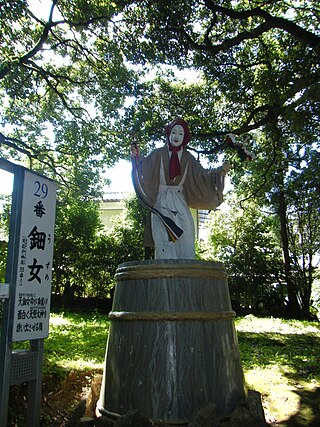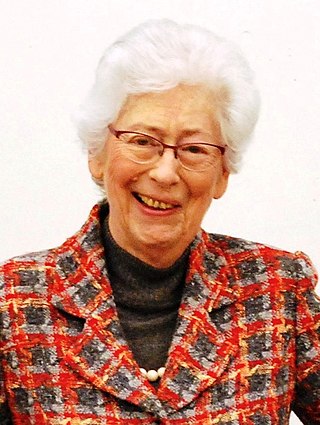
Religion in Japan is manifested primarily in Shinto and in Buddhism, the two main faiths, which Japanese people often practice simultaneously. According to estimates, as many as 80% of the populace follow Shinto rituals to some degree, worshiping ancestors and spirits at domestic altars and public shrines. An almost equally high number is reported as Buddhist. Syncretic combinations of both, known generally as shinbutsu-shūgō, are common; they represented Japan's dominant religion before the rise of State Shinto in the 19th century.
The Humanity Declaration is an imperial rescript issued by Hirohito, the emperor of Japan, as part of a New Year's statement on 1 January 1946 at the request of the Supreme Commander for the Allied Powers. In the rescript, which started with his citation of the Five Charter Oath of 1868, the Emperor denied the concept of his divinity, which would eventually lead to the promulgation of the new Constitution, under which the Emperor is "the symbol of the State and of the unity of the people".

Ame-no-Uzume-no-Mikoto is the goddess of dawn, mirth, meditation, revelry and the arts in the Shinto religion of Japan, and the wife of fellow-god Sarutahiko Ōkami. She famously helped draw out the missing sun deity, Amaterasu Omikami, when she had hidden herself in a cave. Her name can also be pronounced as Ama-no-Uzume-no-Mikoto. She is also known as Ōmiyanome-no-Ōkami, an inari kami possibly due to her relationship with her husband. She is also known as Ame-no-Uzume-no-Mikoto, The Great Persuader, and The Heavenly Alarming Female. She is depicted in kyōgen farce as Okame, a woman who revels in her sensuality.
Interpreting is a translational activity in which one produces a first and final target-language output on the basis of a one-time exposure to an expression in a source language.

Ame-no-Nuboko is the name given to the spear in Shinto used to raise the primordial land-mass, Onogoro-shima, from the sea. It is often represented as a naginata.

Tomoe, commonly translated as "comma", is a comma-like swirl symbol used in Japanese mon. It closely resembles the usual form of a magatama.

The United Nations Interpretation Service is a part of the Meetings and Publishing Division (MPD) of the UN's Department for General Assembly and Conference Management (DGACM). Its core function is to provide interpretation from and into Arabic, Chinese, English, French, Russian and Spanish for meetings held at United Nations Headquarters, and those at other locations which the department is responsible for servicing. Interpretation is essential to the inter-governmental bodies for the proper conduct and smooth functioning of their deliberations.

Igor Korchilov is a top-level Russian-English conference interpreter who worked with Soviet leader Mikhail Gorbachev from 1987 to 1990, a period that covered the Cold War era.
Herbert Feis was an American historian, author, and economist who was the Advisor on International Economic Affairs in the US Department of State during the Herbert Hoover and Franklin Roosevelt administrations.

East Asia is a geographical and cultural region of Asia including the countries of China, Japan, Mongolia, North Korea, South Korea, and Taiwan. Additionally, Hong Kong and Macau are two coastal cities located in the south of China with autonomous status under Chinese sovereignty. The economies of China, Japan, South Korea, and Taiwan are among the world's largest and most prosperous. East Asia borders Siberia and the Russian Far East to the north, Southeast Asia to the south, South Asia to the southwest, and Central Asia to the west. To its east is the Pacific Ocean.
Danica Seleskovitch was a French conference interpreter, teacher and prolific academic writer on translation studies. Among other career milestones, she founded the Interpretive Theory of Translation.
Conférence Internationale Permanente d'Instituts Universitaires de Traducteurs et Interprètes, abbreviated as CIUTI, is an international academy associating translation and interpretation institutes affiliated to universities.
Kotoshironushi (事代主神), also known as Yae Kotoshironushi no kami (八重言代主神), is a Shinto kami.
Jean-Pierre Armengaud is a French music educator, musicologist, researcher and pianist.

Susanna Vernon was a pioneer conference interpreter, one of the first to practice simultaneous interpretation, in which the interpreter interprets while the speaker is still speaking.
Yakusanoikazuchi or ikazuchi is a collective name for the eight kami of thunder in Japanese mythology. Each one represents a different type of storm.

Marianne Lederer (born 1934) is a French translation scholar. Lederer further developed the Interpretive Theory of Translation together with Danica Seleskovitch, who first proposed the theory. Lederer also published several works on translation and interpreting pedagogy. Her works have greatly influenced interpreting and translation research and teaching internationally.
Kamo no Okimi was the son of Kotoshironushi and Tamakushi-hime, and brother of Himetataraisuzu-hime. He was an ancestor of the Kamo clan, and by extension through Ōtataneko (太田田根子) the Miwa clan.

Isono Shrine (伊曽乃神社) is a Shinto shrine located in Saijō, Shikoku, Ehime Prefecture, Japan. It is a Beppyo shrine. It is notable for two different festivals: Saijo Matsuri, and Isono Jinja Sairei.










